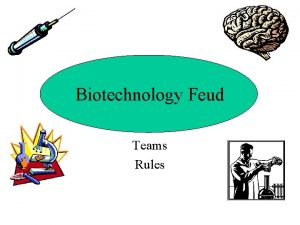Integrating Peers Into Interdisciplinary Health Care Teams Using































































- Slides: 63

Integrating Peers Into Interdisciplinary Health Care Teams Using Peer Support to Engage & Retain Patients in HIV Care & Treatment WELCOME! BU School of Public Health JRI Health

SESSION I: PEER ROLES

Peer Roles Instrumental Support Emotional Support Informationa l Support Affiliational Support

PEER ATTITUDES AND BELIEFS ABOUT HIV Positive Emotion Disclosure Healthy Denial Optimism Values Negative Emotion Non-disclosure Fatalism Pessimism Disregard

Peers gain immediate credibility and trust Peers give access to someone who has been there WHAT MAKES PEERS UNIQUE? Peers share personal experiences Peers focus on empowerment and self-determination

SESSION II: PEERS AS PART OF INTERDISCIPLINARY TEAMS

Island Exercise • Break out into small groups • Each group receives a set of cards that show available resources, including people resources. • The volcano, palm trees and banana trees are additional survival resources • The goal is to create a plan of survival on the island • You must use all of the resources at your disposal • Each group must answer the following questions: • What do we need to survive? • What resources do we have? • What is our group’s survival plan?

DEFINITION OF A CARE TEAM q q A care team is a group of people with different areas of expertise that utilizes the different perspectives of the members of the team and works for a common goal It is vital that each member of the team continually supports the other members in order to optimize results

Historic Approach Doctor Interdisciplinary Approach Doctor Nurse Patient Social Worker Nutritionist Patient Peer Social Worker

COMPONENTS OF A WELL-FUNCTIONING TEAM Team Recognizes strengths & gaps of others Team pays attention to own problemsolving process Team knows role definition, communicatio n, clearly defined goal Team understands how each member contributes to the solution Team understands overall problem/goal Team aware of potential contributions of others

ORIENTING THE TEAM Team understands the unique role, philosophy and goals of peer work 11 Team knows how to discuss peer services with patients Team views peers as colleagues with unique perspective Team plans services together Team creates a work culture that is welcoming and values peer role Team contributes to the ongoing development of peer

SESSION III: PEER SUPERVISION

K E Y Admin Supervision al n c i in isio l C erv p Su Supportive Supervision T O P E E R S U C C E S S

Administrative Supervision Setting clear job expectations Developing goals aligned with program mission/goals Supporting team integration efforts Encouraging professional development Problem solving Managing logistics Evaluating the effectiveness of goals

Administrative Supervision: Who & How often Regularly scheduled meetings or time Whoever is in charge of where peers are placed can offer administrative supervision

Supportive Supervision Builds and sustains a trusting relationship between peer and supervisor Helps transfer personal knowledge Assists in formulating patient care plans Supports peers in maintaining boundaries Supports peers in identifying and addressing issues related to working with patients Supports peers in managing feelings about patients

Clinical Supervision Offered to pre-licensed, licensed and non-clinicians Provides the opportunity for peers to learn about transference/countertransference Provides the opportunity for peers to learn about mental health issues Supports development of patient care plans Ensures that peers work within scope of their role and make appropriate referrals if needed Supports the peer in understanding how the work affects him/her

Supportive & Clinical Supervision: Who & How often? Regularly scheduled meetings or time Administrative and either supportive or clinical; ideally shouldn’t be the same person Supportive supervision can be provided by a nonlicensed practitioner Clinical supervision is always provided by a licensed practitioner

S U P P O R T I V E S U P E R V I S I O N Flexibility Appropriate Supervision Value Opportunity Relapse Income Training Environment Structure

FRAMEWORK FOR SUPPORTING & COACHING PEER SUPERVISEES Create the Space • Accept Peer • Implement Plan • Evaluate • Set the Agenda • Assess Goal Setting Continuous Feedback • Develop Plan • Provide Resources 20 Case Consultation

“Te sugiero conseguir un perro. ”

THE INVISIBLE SIGN Everyone has an invisible sign hanging from the neck saying: ‘Make Me Feel Important!’ Never forget this message when working with people 22 - Mary Kay Ash, Cosmetics Entrepreneur

GIVING FEEDBACK CAN ENCOURAGE OR DISCOURAGE “You are totally irresponsible! Don’t let this happen again” 23 “I get concerned when you arrive late because our patients are left waiting”

SPECIFIC FEEDBACK provides an open, honest opportunity for improvement 24

GIVING SPECIFIC FEEDBACK “Don’t you care about your job? The paperwork is a disaster!” “You are really good” 25 “ “I get concerned when you don’t complete the paperwork because this could impact our funding” “I’m so glad you’re kind toward your patients; it’s making a real difference in their lives”

FEEDBACK CAN OPTIMIZE PERFORMANCE To Motivate To Correct Positive feedback can increase employee confidence and encourage individuals to continue at or above present level of performance. Addressing performance issues helps employees determine how to change/improve performance, which can increase feelings of competence. 26

Feedback produces results Corrective -Provides valuable info --Discovers the “whys” of not meeting work expectations -Allows supervisor to address ongoing performance Positive Creates a culture of open communication that utilizes a variety of feedback mechanisms Successful Outcomes

Don’t Specific F E E D B A C K F R A M E W O R K Constructive • Progressive • Gentle • Supportive • Positive Timely “You’re a great listener” Do “When you looked directly at me I felt heard” “You need to ask “I really liked better questions” when you asked an openended question - try to do that more often” Wait until next month’s supervision Give feedback in real time

S D h e a b d r o i w e i f n i g n g 29 F e e d b a c k ROLE PLAY Instructions: Ø Peer is shadowed by supervisor Ø Supervisor debriefs with peer Ø Supervisor gives feedback Ø Supervisor demonstrates feedback by role playing with peer

SESSION IV: CONFIDENTIALITY AND BOUNDARIES

WHAT IS CONFIDENTIALITY? • Trusting another person with information that will not be shared • Keeping sensitive information protected from unauthorized viewers • Ensuring that information is accessible only to those authorized to have access

CONFIDENTIALITY Questions to Consider • Why is confidentiality so important? • What are things that need to be kept confidential? • What are some inappropriate places to discuss patient information?

Health Insurance Portability and Accountability Act (HIPAA) The federal government established this act to maintain and protect the rights and interest of the patient. HIPAA defines the standard for electronic data exchange, protects confidentiality and security of health care records. The privacy or confidential rules regulate how information is shared. Upon engagement of health services: pharmacy, medical visit, social services etc. , the patient is informed of his rights to confidentiality and the policy and procedures regarding the release of his personal health information. The patient signs form stating that he or she received and reviewed HIPAA policy.

Situations when data can be released without the patient’s permission or consent • • For the purpose of reporting abuse or neglect of a child, elderly or disabled person to the proper social service agency. If a patient is suicidal or homicidal, or an actual homicide committed.

What happens when confidentiality is not respected or is breached The patient may be embarrassed. The patient can lose trust in the peer and the agency. The patient may file charges against the peer and the agency. Employee may be reprimanded, given a warning or be dismissed from the agency. The agency could be fined criminal penalties for disregarding HIPAA.

Supervision Strategies for Confidentiality Review program policies/procedures on patient confidentiality-HIPAA laws. Expect peers to adhere to HIPAA laws. Encourage peers to respect patient’s confidentiality. Remind peers to have signed patient consent forms before sharing information.

BOUNDARIES

Types of Boundaries are standards and limits developed to create an environment of safety and well-being. Common boundaries are: Physical boundaries- one’s sense of personal space Time and place boundary – when, where to meet Emotional boundaries-feelings that separate an individual from others Personal belief

Examples of when physical boundaries are not respected When someone approaches to talk about an issue and they get too close Looking through patient files, documents without permission Inappropriate touching such as unwanted sexual advances

Example of a physical boundary that was addressed in supervision A peer is preparing medical charts for the next day’s clinic. The charts have been pulled and the supervisor notices that the peer is looking through a patient’s medical chart. When the supervisor approaches, the peer says, “Hey, I know him; we went to high school together. ”

Supervisory Strategies Model statements peers can use to patients or coworkers to respect physical space Review program policies/procedures on patient confidentiality-HIPAA laws Examine with peers how patient data can support achievement of adherence goals Encourage peers to review agency employee handbooks to support safety in the work environment

What Are Time Boundaries? Time boundaries refer to markers of time Examples: 1. 2. 3. Start times and end times for work Allotting time to meet with a patient that allows for enough time to achieve goals Ending a meeting with a patient after an appropriate period of time, even if the patient wants to continue

Supervisory Strategies Expect peers to be on time Coach peers to begin and end patient meetings on time and within reasonable timeframes Teach peers to communicate to patients how long meetings will last Consider protocols regarding when peers may meet with patients Remember time boundaries demonstrate respect for supervisors, peers AND patients Model good time boundaries as a supervisor

What Are Place Boundaries? Place boundaries help programs define best practices for where peers meet with patients Program managers and supervisors will want to consider the local community, the local medical network, safety issues, and the role of peer work.

Supervisory Strategies Decide where peers and patients can meet and clearly communicate to peer staff Consider allowing for flexibility based on patient needs and peer’s experience Review issues regarding “safety in the field” and encourage peers to express any feelings of lack of safety.

Examples of When Emotional Boundaries Are Crossed Blaming others, not taking personal responsibility for actions Imposing one’s feelings or ideas on another Allowing patient statements to have a negative impact on services the peer is providing; patient may insist that they are not being helped

Supervisory Strategies Process with peers responses to peer/patient exchanges Coach peers to separate what they do and do not have control over Teach peers to let go of work-related issues after their assigned work hours Encourage peers to set boundaries with patients, health care staff and interdisciplinary teams Model self-care

Defining Personal Beliefs for Peers A personal belief includes one’s world view, values and life philosophies. Personal beliefs include one’s religious beliefs and political beliefs, etc. We all have a right to our beliefs, but sometimes our actions must be controlled in order to respect the rights of others. This is an example of holding a boundary.

Supervisory Strategies Encourage peers to allow beliefs to support and inspire them, without imposing those beliefs on patients. Find ways for peers to learn about cultural and other differences. Encourage peers to consider individual differences between people with similar belief systems.

Boundaries, the Interdisciplinary Team, and Supervisory Considerations Peers may identify more with patient role than coworker/colleague role Peers may defer decision-making to providers Lack of time boundaries (i. e. , lateness) may indicate peers’ misunderstanding of their importance Providers may balk at communicating boundary issues because they are afraid of offending peers Peers may elicit caretaking from providers, and/or providers may take the lead by offering it

Supervisory Strategies Continually communicating to peers their value and importance (use specific examples) Reminding peers that their input is the voice of patient advocacy Communicating professional norms to peers and educating providers to do the same Helping peers talk through how to distinguish between their roles as a patient versus peer provider

Summary of Tips for Setting Boundaries: Skills Clearly define the peer/patient relationship/roles Set guidelines so patients know what to expect in peer sessions Immediately let others know that they crossed boundaries It’s important to implement a boundary once it’s set Follow through on what you said you would do Share how they crossed set boundaries Separate out boundary-setting and being empathic to the peer’s need to share his/her feelings

WHAT IS TRANSFERENCE/ COUNTERTRANSFERENCE? Unconscious redirection of feelings from one person to another Inappropriate response in the present triggered by a past relationship

TRANSFERENCE v v Peer represents something other than peer for the patient Patient has assigned certain feelings to peer that are unrelated to peer Patient has certain expectations because of these assumptions and feelings Patient may act on these feelings and not realize it

MANAGING TRANSFERENCE v v Help peer to recognize that feelings are normal Support peer in addressing these feelings v Refer peer for added support v Transfer patient case (if necessary) v Address boundary policies

COUNTERTRANSFERENCE q Belief of exactly what a patient needs to do q q q Assumptions about a patient without checking them out q q q Going out of the way for a patient, over-extending oneself even though patient is not working very hard for him- or herself. Avoiding patient q q Feeling of being manipulated Spending too much time with one patient for an extended period of time Attraction to a patient Unrealistic expectations of a patient Patient reminds peer of someone in the peer’s life

I can’t believe this, she’s been having unprotected sex with her partner without disclosing her status? I have to tell her right now… 57 This is how I got infected – Tom didn’t disclose to me and I had to find out the hard way!

MANAGING COUNTERTRANSFERENCE ü Question assumptions ü Remember limits ü Remember that supporting patients does not always have ideal outcomes ü Get help if needed. ü Get supportive feedback ü Consider feelings about the patient (s) that trigger peer ü ü ü Talk to a trusted colleague, supervisor, counselor, or other supportive person. Engage in a stressreduction technique of any sort. Reassess boundaries with a patient (s). Consider spending more or less energy on this person Remember that the most important job is to role model self-care

The key to success in managing the transference/countertransfer ence is the ability to endure the tension of the opposites without abandoning the process

DOCUMENTATION

DOCUMENTATION TIPS ü ü ü Peers must document their work with patients Objectivity needs to be observed when writing progress notes (use of phrases like “patient states” or “according to patient”, etc. ) Using a good tool can facilitate note writing Each unit of service should have a corresponding progress note (support group and individual) Some peers may have difficulties with writing and may need extra support from supervisor

DOCUMENTATION ROLE-PLAY

NEXT STEPS AND TRAINING EVALUATION
 Integrating public health and primary care
Integrating public health and primary care Quotation acceptance form
Quotation acceptance form Integrating sources into your writing
Integrating sources into your writing Primary secondary and tertiary care
Primary secondary and tertiary care Health and social care values unit 2
Health and social care values unit 2 Health and social component 3
Health and social component 3 Peers for hope house
Peers for hope house Peer coaching dalam plc
Peer coaching dalam plc Connected peers meaning
Connected peers meaning Setting of a jury of her peers
Setting of a jury of her peers Nehemiah institute peers test
Nehemiah institute peers test Peers and friend
Peers and friend Peer coaching maksud
Peer coaching maksud Peers as partners in learning
Peers as partners in learning Matlamat bercirikan peers
Matlamat bercirikan peers This is an informal language used by peers and friends
This is an informal language used by peers and friends This is an informal language used by peers and friends
This is an informal language used by peers and friends Pieter peers
Pieter peers Peers goals
Peers goals Mary peers
Mary peers Why is environmental science considered interdisciplinary?
Why is environmental science considered interdisciplinary? Multidisciplinary vs interdisciplinary
Multidisciplinary vs interdisciplinary Interdisciplinary multidisciplinary transdisciplinary
Interdisciplinary multidisciplinary transdisciplinary Interdisciplinary teamwork
Interdisciplinary teamwork Interdisciplinary progress notes
Interdisciplinary progress notes Interdisciplinary thematic units
Interdisciplinary thematic units What is interdisciplinary
What is interdisciplinary Interdisciplinary studies ucf
Interdisciplinary studies ucf Interdisciplinary engineering tamu
Interdisciplinary engineering tamu Why is oceanography considered an interdisciplinary science
Why is oceanography considered an interdisciplinary science Interdisciplinary lenses
Interdisciplinary lenses Carnegie mellon interdisciplinary
Carnegie mellon interdisciplinary Interdisciplinary field
Interdisciplinary field Evans center for interdisciplinary biomedical research
Evans center for interdisciplinary biomedical research Interdisciplinary approach to problem solving
Interdisciplinary approach to problem solving Linguistic branch
Linguistic branch Interdisciplinary math lesson plans
Interdisciplinary math lesson plans Zeigler 1990 interdisciplinary
Zeigler 1990 interdisciplinary Interdisciplinary multidisciplinary transdisciplinary
Interdisciplinary multidisciplinary transdisciplinary Tragedy of the commons
Tragedy of the commons Global carbon project
Global carbon project Interdisciplinary approach to climate change
Interdisciplinary approach to climate change Embedded quotes mla examples
Embedded quotes mla examples Sensory input integration and motor output
Sensory input integration and motor output Integrating factor method
Integrating factor method Integrating classification and association rule mining
Integrating classification and association rule mining Cad integration for dynamics ax
Cad integration for dynamics ax Basic concepts on integrating technology in instruction
Basic concepts on integrating technology in instruction Solution to it
Solution to it Integrating marketing communication to build brand equity
Integrating marketing communication to build brand equity Key internal forces
Key internal forces Corporate social responsibility vs conscious marketing
Corporate social responsibility vs conscious marketing Non exact differential equation calculator
Non exact differential equation calculator Integrating type dvm
Integrating type dvm Integration by parts meaning
Integration by parts meaning Differentiating relationship stage
Differentiating relationship stage Integrating factor of differential equation
Integrating factor of differential equation Dialogue quote vs flow quote
Dialogue quote vs flow quote Separation of variables differential equations
Separation of variables differential equations Integrating factor of differential equation
Integrating factor of differential equation The intent of project metrics is:
The intent of project metrics is: Blending quotations
Blending quotations Integrating business perspectives
Integrating business perspectives Integrating science and social studies
Integrating science and social studies






















































































